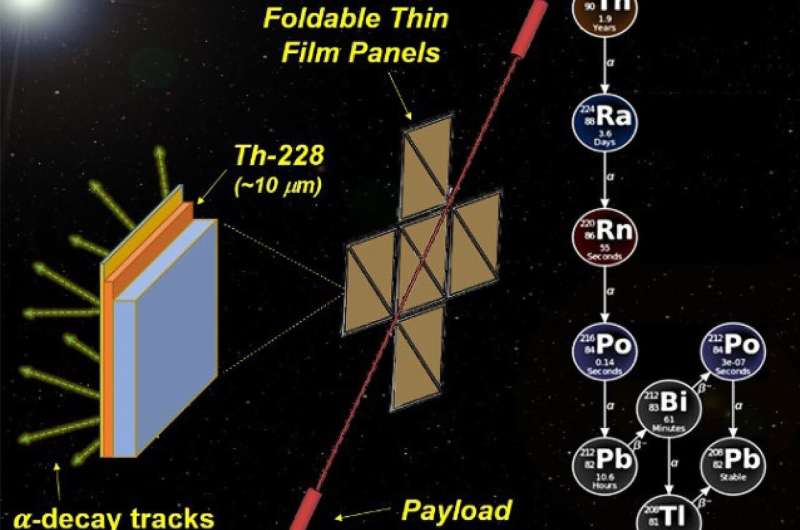This article has been reviewed according to Science X's editorial process and policies. Editors have highlighted the following attributes while ensuring the content's credibility:
fact-checked
trusted source
proofread
NASA invests in new nuclear rocket concept for the future of space exploration and astrophysics

In the coming years, NASA plans to send several astrobiology missions to Venus and Mars to search for evidence of extraterrestrial life. These will occur alongside crewed missions to the moon (for the first time since the Apollo Era) and the first crewed missions to Mars.
Beyond the inner solar system, there are ambitious plans to send robotic missions to Europa, Titan, and other "Ocean Worlds" that could host exotic life. To accomplish these objectives, NASA is investing in some interesting new technologies through the NASA Innovative Advanced Concepts (NIAC) program.
This year's selection includes solar-powered aircraft, bioreactors, lightsails, hibernation technology, astrobiology experiments, and nuclear propulsion technology. This includes a concept for a Thin Film Isotope Nuclear Engine Rocket (TFINER), a proposal by senior technical staff member James Bickford and his colleagues at the Charles Stark Draper Laboratory—a Massachusetts-based independent technology developer.
This proposal relies on the decay of radioactive isotopes to generate propulsion and was recently selected by the NIAC for Phase I development.
As their proposal paper indicates, advanced propulsion is essential to realizing several next-generation mission concepts. These include sending a telescope to the focal point of the sun's gravitational lens and a rendezvous with a passing interstellar object. These mission concepts require rapid velocities that are simply not possible with conventional rocketry.
While lightsails are being investigated for rapid-transit missions within the solar system and Proxima Centauri, they cannot make the necessary propulsive maneuvers in deep space.
Nuclear concepts that are possible with current technology include nuclear-thermal and nuclear-electric propulsion (NTP/NEP), which have the necessary thrust to reach locations in deep space. However, as Bickford and his team noted, they are also large, heavy, and expensive to manufacture.
"In contrast, we propose a thin film nuclear isotope engine with sufficient capability to search, rendezvous, and then return samples from distant and rapidly moving interstellar objects," they write. "The same technology allows a gravitational lens telescope to be repointed so a single mission could observe numerous high-value targets."
The basic concept is similar to a solar sail, except that it relies on thin sheets of a radioactive isotope that uses the momentum of its decay products to generate thrust.
As they describe it, the baseline design incorporates sheets of the Thorium-228 measuring about ~10 micrometers (0.01 mm) thick. This naturally radioactive metal (typically used in radiation therapy) undergoes alpha decay with a half-life of 1.9 years. Thrust is produced by coating one side with a ~50-micrometer (0.05 mm) thick absorber layer, forcing alpha particles in the direction opposite of travel.
The spacecraft would require 30 kg (66 lbs) of Thorium-228 spread over an area measuring over 250 m2 (~2,700 square feet), providing more than 150 km/s (93 mi/s) of thrust.
For comparison, the fastest mission that relied on conventional propulsion was the Parker Solar Probe (PSP), which achieved a velocity of 163 km/s (101 mi/s) as it reached the closest point in its orbit around the sun (perihelion). However, this was because of the gravity-assist maneuver with Venus and the pull of the sun's gravity.
The advantages of this system include simplicity, as the design is based on known physics and materials. It also offers scalability to accommodate smaller payloads (like sensors) or larger missions (like space telescopes).
A single conventional launch vehicle could insert several of these spacecraft into a solar escape trajectory, requiring an escape velocity of 42.1 km/s (26 mi/s). The thrust sheets can also be reconfigured to enable thrust vectoring and spacecraft maneuvers, meaning that the spacecraft could scout for future missions once it reaches deep space.
This includes telescopes bound for the Solar Gravitational Lens' (SGL) focal point and missions that will rendezvous with interstellar objects (ISOs) and possibly return samples to Earth for analysis. Speaking of which, the spacecraft would have the spare capacity to rendezvous with an ISO on its own and return samples.
The natural decay of the sheets can also be harnessed using a layer of thermoelectric materials (or Peltier Tiles) to generate excess electrical power of about 50 kW at 1% efficiency. A layer of beta-particle emitting material could also be added to neutralize the alpha radiation and "induce a voltage bias that directs exhaust emissions and/or exploits outbound solar wind."
They also note how the concept can be designed with multiple "stages" equipped with Actinium-227 (or other isotopes with a longer half-life), leading to higher velocity over extended mission lifetimes. Similarly, a modified version that relies on Thorium-233 can harness the Thorium fuel cycle—a cascading isotope decay that eventually produces Uranium-232—that will result (they claim) in an increased performance of about 500%. Clearly, the proposed technology presents many opportunities for future development and could be used to execute several mission profiles.
These missions align with NASA's vision for the coming century, which includes sending spacecraft to study ISOs up close, discover habitable planets in neighboring star systems, conduct crewed missions beyond the Earth-moon system, and search for life on other celestial bodies.
Provided by Universe Today





















